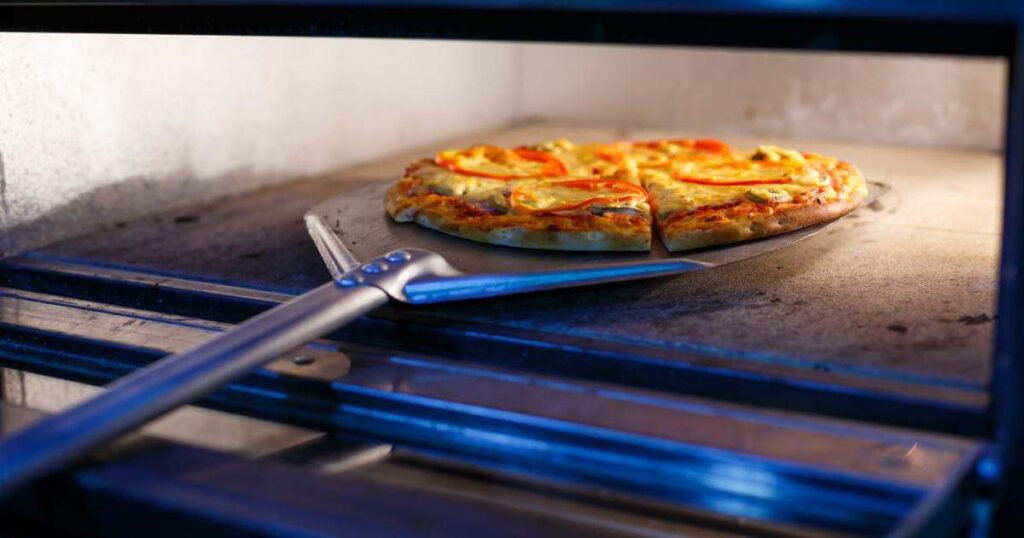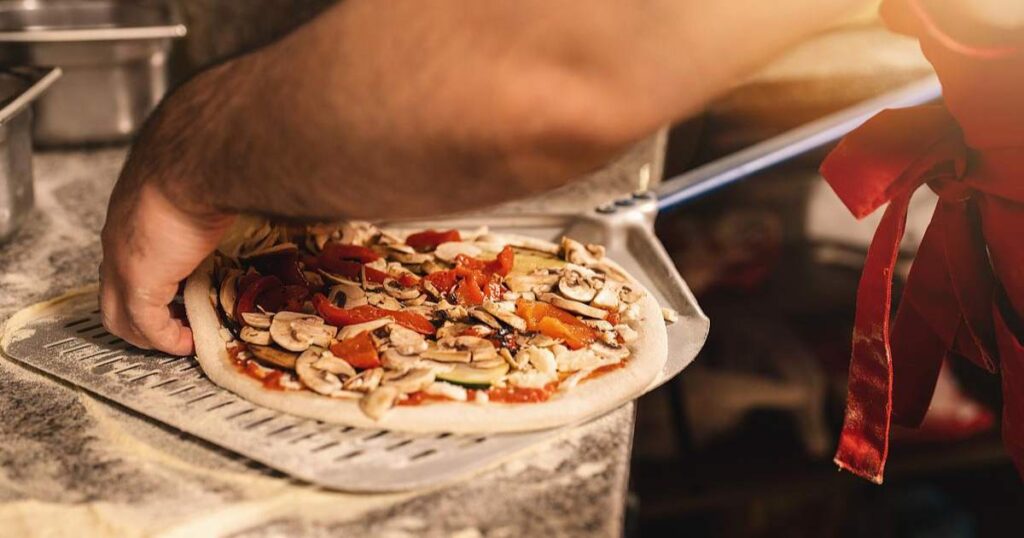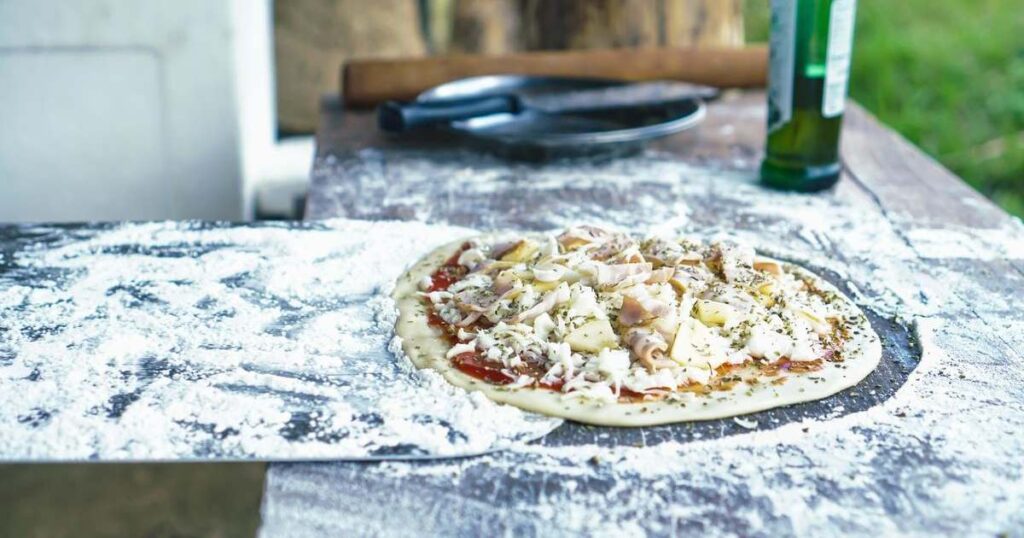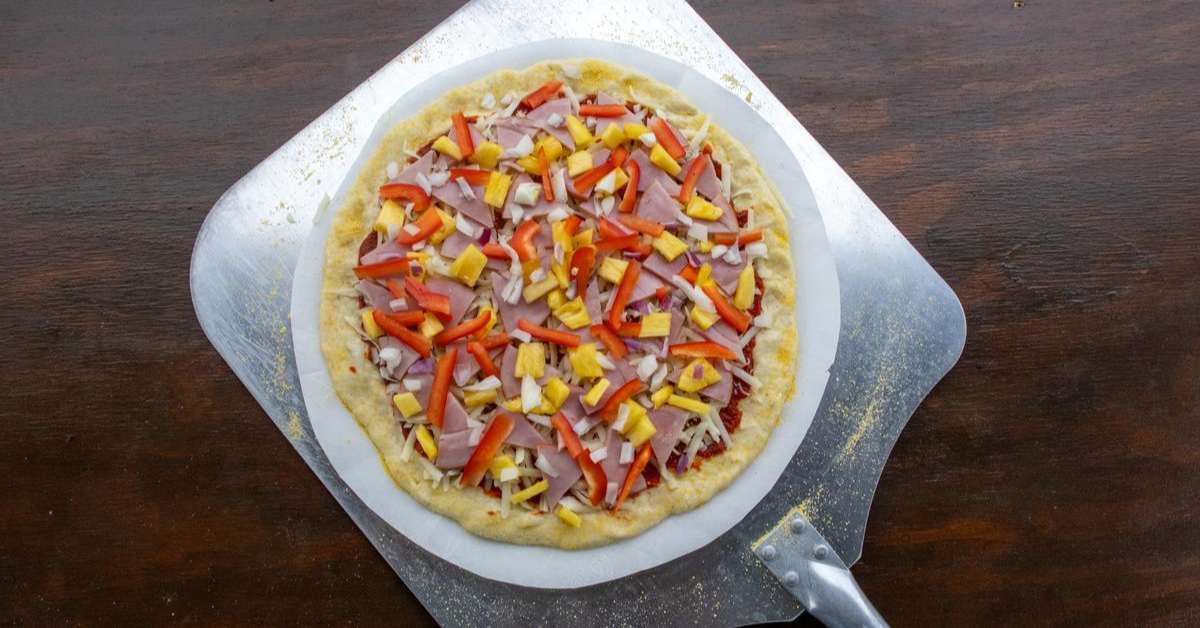When creating the perfect homemade pizza, mastering the art of using a pizza peel is crucial. The joy of crafting your pizza dough, layering it with your favorite toppings, and anticipating that crispy, golden crust can be unmatched. However, one common hurdle many pizza enthusiasts face is the dough sticking to the peel.
Don’t worry – we’ve got you covered! In this guide, we’ll unravel the secrets of preventing your pizza dough from sticking to the peel, ensuring that your culinary creations smoothly transition from peel to plate. Let’s dive into the tips and techniques to elevate your pizza-making game.
Table of Contents
ToggleWhat is The Peel and Why it’s Important

The pizza peel, a seemingly humble kitchen tool, is pivotal in creating a pizza masterpiece. It’s a flat paddle, often made of wood or metal, that serves as a transportation device and a surface for assembling your pizza.
The peel allows you to effortlessly slide your pizza onto a hot oven stone or baking surface and quickly retrieve it once it’s perfectly cooked.
Its importance lies in the delicate dance it performs between your carefully crafted pizza and the scorching heat of the oven.
The peel’s smooth surface, often lightly dusted with flour or cornmeal, prevents the dough from adhering to it during transfer. This facilitates a seamless transition from your prep station to the fiery oven.
Why Pizza Dough Sticks to the Peel
The frustration of watching your meticulously crafted pizza dough cling stubbornly to the peel is a common woe among home chefs.
But fear not, for understanding why this sticky situation occurs is the first step toward preventing it. Several factors contribute to this culinary conundrum.
Firstly, excess moisture can be a culprit. When the dough contains too much moisture or the peel is damp, it can create a sticky bond. Secondly, inadequate flour or cornmeal on the peel’s surface can lead to direct contact between the dough and the peel, resulting in adherence.
Lastly, if the dough is left on the peel for an extended period before baking, it can become stickier due to its interaction with the peel’s surface.
How to Prepare the Peel
Crafting a successful pizza begins with proper preparation, and the pizza peel plays a crucial role in this endeavor. Here’s how you can ensure your peel is ready for action:
Selecting the Right Type of Peel:
Choose a pizza peel that suits your needs. Wooden peels are traditional and offer a rustic charm, while metal peels are excellent for sliding pizzas into ovens due to their thin edges. Additionally, consider investing in a peel with a perforated surface to prevent excessive flour accumulation.
Preheating the Peel:
Before placing your pizza on the peel, give it a brief preheating? This can be done by leaving the peel in the oven for a few minutes, allowing it to absorb some heat. A warm peel reduces the risk of dough sticking.
Dusting the Peel with Flour:
Lightly dust the peel’s surface with flour or cornmeal. This fine layer is a barrier between the dough and the peel, preventing adhesion. Remember, a little goes a long way – excessive flour can affect the texture of your pizza.
By meticulously preparing your peel, you’re setting the stage for a seamless transfer of your pizza from peel to the oven, ensuring that your culinary masterpiece doesn’t meet an unfortunate end stuck to the wrong surface.
How to Shape the Dough

Shaping the pizza dough is a pivotal step that significantly influences the outcome of your pizza. Follow these steps to ensure your dough is perfectly shaped and ready for the peel:
Resting and Acclimating:
Allow your pizza dough to come to room temperature after being removed from the refrigerator. This makes it more pliable and easier to work with. Give it time to relax and acclimate, preventing it from springing back excessively during shaping.
Gentle Pressing:
Begin by gently pressing down the center of the dough ball with your fingertips. Gradually work your way outward, leaving the outer edge slightly thicker. This creates the classic crust’s puffiness while maintaining a thinner center for toppings.
Hand Tossing (Optional):
If you’re feeling adventurous, you can attempt the classic pizza toss. Toss the dough in the air while rotating it to achieve an even thickness distribution. This technique requires practice, so don’t worry if it takes a few tries.
Final Stretching:
Place the dough on a floured surface and use your hands to stretch it to the desired size gently. Avoid using a rolling pin to compress the dough and prevent proper oven rise.
By mastering the art of shaping pizza dough, you’re enhancing its appearance and setting the stage for a successful transition from peel to plate. The well-shaped dough ensures even baking and a satisfyingly crispy crust.
Toppings and Sauce
Selecting the right toppings and sauce can elevate your homemade pizza from ordinary to extraordinary. Here’s how to make informed choices that enhance both flavor and texture:
Balancing Flavors and Textures:
When choosing toppings, aim for a balance of flavors and textures. Combine different savory, sweet, and tangy elements to create a harmonious taste experience. Additionally, vary the textures by including crunchy vegetables, gooey cheese, and tender meats.
Prepping Ingredients:
Prepare your toppings ahead of time to ensure a seamless assembly process. Slice vegetables, cook meats, and grate cheese so that everything is ready when it’s time to top the dough.
Saucing Techniques:
When applying sauce, start from the center and use a circular motion to spread it evenly towards the edges. Avoid overloading the center with relish, as it can make the pizza soggy.
Cheese Considerations:
For optimal melt and flavor, use a blend of cheeses. Mozzarella is a classic choice, but experimenting with other varieties like cheddar, fontina, or gouda can add depth to your pizza.
Remember, the toppings and sauce you choose should complement each other and interact harmoniously with the crust.
Launching the Pizza
As you prepare to transfer your pizza masterpiece from peel to oven, mastering the launching technique is essential for a successful outcome. Follow these steps to ensure a smooth and confident launch:
Checking Readiness:
Ensure your pizza is fully assembled on the peel and ready for baking. Double-check that the toppings, sauce, and cheese are in place.
Positioning the Peel:
Position the peel at a slight angle towards the oven. This angle helps with the sliding motion as you launch the pizza.
Confident Slide:
Slide the pizza from the peel onto the preheated oven stone or baking surface swiftly and confidently. Use a gentle jiggle or back-and-forth motion to encourage the pizza to slide off smoothly.
Avoiding Overhandling:
Once the pizza is on the oven surface, avoid excessive handling. This prevents disruptions to the dough’s position and helps maintain its shape.
Closing the Oven:
Close the oven door promptly to retain the high temperature necessary for baking. This will ensure your pizza cooks evenly and develops that coveted crispy crust.
Mastering launching effectively brings your pizza creation to life in the oven. With a well-practiced technique, you’ll confidently slide your pizza into the fiery depths, eagerly anticipating the transformation that will occur within.
Troubleshooting Stuck Pizza

Encountering a stuck pizza can be disheartening, but fear not – there are ways to salvage the situation. If your pizza appears to be firmly adhered to the peel, here are some tips to help you free it:
Gentle Maneuvering: Using a soft touch, try to carefully lift the edges of the stuck pizza with a spatula or your fingers. Slowly work around the pizza, releasing it from the peel’s surface.
Adding Flour: If the dough is sticking due to moisture, sprinkle a small amount of flour or cornmeal beneath the pizza. This can create a barrier that helps loosen the bond between the dough and the peel.
Using Parchment Paper: Placing a piece of parchment paper on the peel before assembling the pizza can provide an extra layer of separation. When ready to launch, the pizza can easily slide onto the oven surface and the parchment paper.
Shift and Shake: If the pizza is only partially stuck, gently shift and shake the peel in a back-and-forth motion. This might help loosen the dough’s grip and allow a smoother launch.
Remember, even the most experienced pizza makers encounter the occasional mishap. Don’t let a stuck pizza deter you – with these troubleshooting techniques, and you’ll be well-equipped to tackle the situation and continue perfecting your pizza-making prowess.
Maintenance and Care of the Peel
Maintaining and caring for your pizza peel ensures longevity and effectiveness in your pizza-making endeavors. Here’s how to keep your peel in top condition:
Regular Cleaning: After each use, clean the peel by removing any residual flour, dough, or toppings. Use a damp cloth or sponge to wipe it down, and avoid using harsh abrasives that could damage the surface.
Oil or Seasoning: If you’re using a wooden peel, consider oiling or seasoning it regularly to prevent the wood from drying out and cracking. Food-safe mineral oil is a suitable option for wooden peels.
Storing: Store your peel in a dry and cool place, away from direct sunlight or excessive humidity. Hanging the peel vertically can help save space and prevent warping.
Inspect for Wear: Regularly inspect the peel for signs of wear, such as cracks, splintering, or loose handles. Address any issues promptly to prevent safety hazards.
Flour or Cornmeal Application: Before each use, lightly dust the peel’s surface with flour or cornmeal to create a non-stick barrier. This practice not only aids in launching the pizza but also protects the peel’s surface.
Giving your pizza peel the attention it deserves ensures its reliability and contribution to your pizza-making success. Proper maintenance allows you to continue crafting delicious pizzas quickly, creating culinary delights that transition effortlessly from peel to plate.
Frequently Asked Questions
How do I keep the pizza dough from sticking to the peel?
To prevent pizza dough from sticking to the peel, ensure the peel is lightly dusted with flour or cornmeal before placing the dough on it. This thin layer is a barrier and allows easy sliding onto the oven surface.
How do you get the pizza off the peel quickly?
To release the pizza effortlessly from the peel, ensure a confident launch with a swift sliding motion. Additionally, ensure the peel is adequately dusted with flour or cornmeal, and consider using parchment paper for added ease.
How do you make pizza not stick to stone?
To prevent the pizza from sticking to a baking stone, ensure the stone is preheated adequately before sliding the pizza onto it. Dusting flour or cornmeal on the stone can also create a non-stick surface.
Why is my pizza dough so sticky?
Sticky pizza dough can result from excessive moisture in the dough or from under-kneading. Adjust the dough’s hydration levels and knead it thoroughly to achieve a smooth, manageable consistency.
How do you keep the dough from sticking to the surface?
Avoid using too much flour on the work surface when working with pizza dough, as excess flour can affect the dough’s texture. Instead, lightly flour your hands and use a gentle touch to shape and stretch the dough.
Conclusion
Mastering the art of preventing pizza dough from sticking to the peel is a journey that involves understanding the role of the peel, honing your dough-shaping skills, and employing effective launching techniques.
By selecting the right peel, properly preparing it, carefully shaping your dough, and choosing well-balanced toppings, you can ensure your pizza-making experience is enjoyable and successful.
Armed with troubleshooting tips and an understanding of peel maintenance, you’re poised to create pizzas that seamlessly transition from peel to plate, delighting your taste buds and culinary aspirations. Happy pizza-making!






